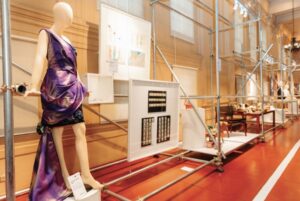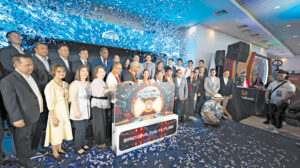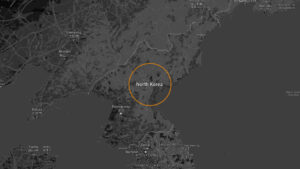What makes a design Filipino?

THE “50 Years of Philippine Design and Beyond” exhibit tried to examine and summarize the movements of the design industry in the Philippines, with a focus on the contributions of the Design Center of the Philippines.
The exhibit, with over 300 images and objects, is on display at the National Museum of Fine Arts, the former Legislative Building. While the exhibit has been up since December last year, as part of the celebrations marking the Design Center’s 50th anniversary after it was founded in 1973, it was formally launched on Feb. 23, with additional items and exhibits. The country’s president, Ferdinand Marcos, Jr. and his wife, Liza Araneta Marcos, toured the exhibit.
“I would like to thank you for the opportunity to come back here in the National Museum, here in the old Session Hall of the Senate,” said Mr. Marcos in a speech. “As a matter of fact, I spent many hours here in this place, waiting for my father to finish his work while he was senator, and then Senate President. I sat there,” he said, motioning to the back of the room. “It’s so nice to be back here. It holds very great memories for me, because these were some of the best times I spent with my father.” During the rule of his father, dictator Ferdinand Marcos, Sr., the senate building was padlocked in 1973 after the abolition of congress, a result of his father’s declaration of Martial Law in 1972.
“This event is extra-special to me, as it was my mother, Imelda Romualdez Marcos, who envisioned a future where design would shine brightly, guiding the path of our nation. In 1973, her vision came to fruition with the establishment of the Design Center, laying the groundwork for Filipino creativity to dazzle the global stage,” he said. The Design Center was established through Presidential Decree No. 279 (“Creating the Design Center of the Philippines to Develop, Promote, and Enhance the Product Design of All Philippine Products and Handicraft”).
SIGNS OF THE TIMESMany of the objects in the exhibit came from this period, including furniture, clothing, movie posters, and even toys. The exhibit is divided into three parts, with the first showing items from 1973 to 2000, then from 2001 to 2023, and “The Future Today.” “The Future Today” section shows projects by the Design Center including Pinyapel, a specialty paper sourced from pineapples that can be made into other objects, and a collection of chairs by contemporary artists innovating on an original 1982 chair by National Artist Arturo Luz.
Unfortunately, it seems that many of the clothes from the 1970s had not survived intact. During the tour, we were shown sketches and plates by boutique Azabache, as they couldn’t find intact clothes from the store, which was then one of Manila’s most famous. Another casualty of time were barongs designed by Jean Paul Gaultier during a stint in Manila as an apprentice of Pierre Cardin, who had a boutique in Manila during that period. All that survives are photographs of the said barongs, displayed in the exhibit.
Still, there are many treasures: there are wooden toys by Francisco Mañosa, National Artist for Architecture, first designed for his children and then later mass-produced, as a response to many imported toys coming into the market (these were even given Filipino names, such as a toy grasshopper called Tipaklong). There were chairs by Designs Ligna, as well as chairs by Betty Chen Cobonpue, mother of Kenneth Cobonpue.
Comics and movie posters for controversial movies like Sister Stella L. and Itim were also on display, with curator Marian Pastor Roces discussing how politics and economics influenced these particular posters (there was the expense of colored posters; the poster for Sister Stella L. was made with woodblock printing, a favored method of Leftist movements here and abroad).
The 2001-2023 collections show magazine shoots, comics like Pugad Baboy and works from the artist Garapata, as well as furniture by Ito Kish, Mr. Cobonpue, and designs by Albert Andrada (such as the blue dress worn by former Miss Universe Pia Wurtzbach at her coronation); among others.
“It’s really about inflection points,” said Maria Rita O. Matute, Executive Director of the Design Center in an interview with BusinessWorld, when discussing how the items were chosen for inclusion in the exhibit. “Did this item, regardless of how beautiful it is — did it signal a change?”
TRANSLUCENCEMs. Matute attempts to make a summary of Philippine design through the items in the exhibition. Asked how one could tell whether a design was Filipino if the viewer were devoid of context, she of course talked about the material, but also, she said, “There’s a certain translucency.” One may look at the dress by Salvacion “Slim” Lim-Higgins, a National Artist for Fashion Design, or else the capiz lamps by the Design Center, but she elaborated, “It doesn’t have to be translucency literally, but there is a sort of crosscurrent — it’s a little bit woven… it’s not solid.”
“There’s an indoor-outdoor feel to it. It’s not solid, visually… there are negative spaces in between,” she said.
Since design is reflective of a people’s culture, she pointed out, “Our private and public spaces — there’s no real demarcation in traditional Philippine architecture. It’s pinapakiramdaman (a concept in Filipino hard to translate, but perhaps “tact” is appropriate) where it becomes private, and where it’s public.
“There are weak signals, but they are signals to show a relationship, or a change in relation, because we’re not confrontational as a people. Everything, you have to feel your way.”
The exhibit is on view until April 21. — Joseph L. Garcia




